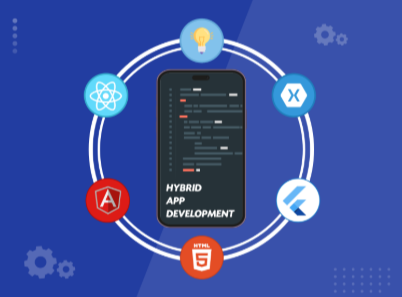What is Hybrid in App Development?
You’ve got a great app idea, but how do you actually build it? That’s one of the first big questions that comes up when you start planning a mobile app. Should you go the traditional route and create separate native apps for iOS and Android? Or maybe lean into web-based options for speed and simplicity?
Then there’s another option that many people hear about: hybrid app development. Hybrid apps offer a common ground between native and web applications, but what does that really mean? More importantly, is it the right choice for your team, your goals, and your users? If you’re looking for hybrid app development services in USA, it’s important to know how this option works before you decide.
What Does Hybrid Mean in Hybrid App Development Services in USA?
Developers build hybrid apps using web technologies like HTML, CSS, and JavaScript, then wrap them in a native shell. This lets the app work like a regular mobile app, which means you can download it from the App Store or Google Play, but it runs more like a website behind the scenes.
It’s called “hybrid” because it mixes two worlds:
Web Apps
These are apps that run inside your browser (like Chrome or Safari). You don’t download them from an app store. Instead, you just visit a link and use the app online (such as apps like Google Docs or a shopping site on your phone). They’re usually quicker to create, easier to update, and don’t require separate versions for each phone.
Native Apps
These are apps made especially for one platform, either Android or iOS, using tools like Swift (for iOS) or Kotlin (for Android). They offer better speed and performance, and provide full access to phone features like the camera, GPS, and push notifications. However, since they’re made separately for each platform, they usually cost more and take longer to develop.
Key Features of Native, Web, and Hybrid Apps
| Feature | Native | Web-only | Hybrid |
| Device Access | Full | Limited | Full (with plugins) |
| Performance | High | Medium to High | Medium to High |
| Development Language | Platform Specific | HTML, CSS, JavaScript | HTML, CSS, JavaScript |
| Cross-Platform Support | No | Yes | Yes |
| User Experience | High | Medium to High | Medium to High |
| Code Reuse | No | Yes | Yes |
Examples of Hybrid Apps
When you scroll through your Instagram feed, you’re using a hybrid app. It shows your feed using web tools, but still feels like a regular mobile app. React Native helps it run well on both iPhones and Android phones.
Uber
Uber also runs on hybrid app development services in USA. The app’s mobile screen is built using a web-based system that runs a version of its website inside the app.
Untappd
Untappd is a hybrid app made with tools like Ruby on Rails and React Native. This lets it work the same way on both iOS and Android without needing two separate apps.
Gmail
It might be surprising, but Gmail is also a hybrid app. Developers use web languages like JavaScript and Vue.js to build it, so it works well on both phones and computers.
The Technology Behind Hybrid Apps
To build these apps, a hybrid app developer relies on well-known tools like React Native, Flutter, and Ionic. These tools make it easier to create apps that work across both iOS and Android without starting from scratch for each platform. Each one has its way of doing things and is better suited for different kinds of projects.
- React Native
Made by Facebook, this tool uses JavaScript, a language already known to a hybrid app developer. It helps apps look and run almost like fully native ones. Also, it has a large online community, making it easier to find support and pre-built tools.
- Flutter
Backed by Google, Flutter uses Dart, a language that’s easy to pick up. It’s great for building smooth, eye-catching apps with custom designs and animations.
- Ionic
Ionic works more like a website within an app. It uses web basics like HTML, CSS, and JavaScript, so it’s ideal for those with web development experience. It’s a good choice for simple apps, especially when used with Angular to keep things well-structured.
Why Developers Prefer Hybrid Apps
Hybrid apps are gaining popularity for several reasons:
1. One Codebase, Two Platforms
You don’t need to write separate code for iOS and Android. Instead, you write the code once and use it on both. This saves time, effort, and money.
2. Faster Development
Because you’re not building from scratch for each platform, hybrid apps are usually quicker to develop. That’s great for businesses on tight deadlines.
3. Easy Maintenance
Updates and fixes are easier to handle with a single codebase. Push the update once, and you’re good to go on both platforms.
4. Access to Device Features
Even though they’re built using web tech, hybrid apps can still access native device features like the camera, GPS, and notifications, thanks to plugins.
Is a Hybrid App the Right Choice for You?
Ask yourself:
- Do you need to get your app launched quickly?
- Are you working with a tight budget?
- Do you want your app to work on both iPhones and Android phones?
- Is your app’s design fairly simple?
If you nodded to most of these, a hybrid APP could be your best choice. It’s a practical, budget-friendly option that makes things easier when you’re just starting out
Still Can’t Decide?
Not sure which type of app is right for your idea? You’re definitely not alone. Instead of trying to figure it all out yourself, it’s much easier to hire hybrid app development services in USA like Apex Web Studios that understands the process. They’ll take a look at your goals, timeline, and budget, and guide you toward the right choice.
What are you waiting for? Get in touch with Apex Web Studios now.






